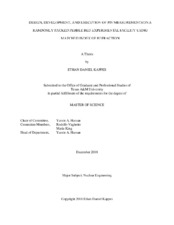| dc.description.abstract | Randomly packed pebble bed structures are found in many engineering applications, such as solar thermal batteries, chemical catalytic reactors, fluid refinement and filtering, magnetic refrigerators, biological tissues, and pebble bed reactors. The critical challenge of designing and analyzing a packed bed structure especially in the nuclear industry comes from its complex and dynamic geometry. Modeling and understanding the complex flow, heat and mass transfer, and vorticity phenomena within the bed on a micro scale involves in-depth analysis of the interstitial regions that make up its entirety. Unfortunately, complex geometries and randomly connected void spaces within packed beds have hindered efforts to characterize the underlying transport phenomena.
Current research lacks analysis and validation against accurate computational fluid dynamics models for randomly packed structures. This lack of understanding prevents proper leveraging of the pebble bed reactor’s passive safety features. Current PIV research that involves randomly packed structures does not also provide a 3-Dimensional (3D) replica of the test bed for verification. Noninvasive measurements coupled with a full 3D test bed replica for computational fluid dynamic verification and validation will lead to a full understanding of the microscopic flow phenomena within pebble bed reactors.
Texas A&M University is conducting isothermal experiments of pressure drops, and flow analysis in a randomly packed pebble bed experimental facility to support the research on advanced nuclear reactors. The data collected is expected to be suitable for computational fluid dynamics validation. The design, construction, and collection of shakedown pressure and PIV data with differing pebble to pipe diameter ratios were conducted in efforts to provide needed data on local flow measurements. The use of nonintrusive PIV analysis on a randomly matched index of refraction facility. This approach allows for a non-invasive probe into the flow within packed spheres at the microscopic scales with high temporal and spatial resolutions. Effects of the wall boundary and Reynolds on flow characteristics obtained from the TR-PIV measurements with are presented with high spatial and temporal resolution. | en |


